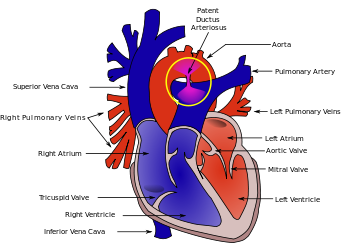
Blood flow in a foetus is different from that of an adult. As lungs are not developed and also not functinal, ductus arteriosus shunts majority of blood to aorta from pulmonary artery. Aorta caries this blood to body.
After birth, lungs expand and carries important function of oxygenation of blood and there is no need of this shunt. The ductus arteriosus closes within a few days after birth. If baby is born premature it may take a longer time.
Patent ductus arteriosus (PDA) is a condition in which the ductus arteriosus remains open. The PDA can be small or large. A large PDA is dangerous because there is large and uncontrolled blood flow to the lungs. It can put a lot of stress not only on heart or lung but also on intestines, brain etc.
What are the symptoms of patent ductus arteriosus?
Symptoms vary depending on the size of the PDA. Patients with a tiny or small PDA usually have no symptoms. It can cause symptoms any time after birth even in adults. Symptoms in patients with a larger PDA include:
- Breathing difficulties soon after birth (especially in premature babies)
- Heart murmur – the heart sounds abnormal when a doctor listens with a stethoscope
- Rapid breathing
- Difficulty in breast feeding; poor growth
- Lung infections (pneumonia)
- Easy fatigability,
How is patent ductus arteriosus diagnosed?
PDA can be diagnosed in any age group from a new born to an adult with a variety of symptoms. Diagnosis of patent ductus arteriosus may require:
- Echocardiogram (also called “echo” or ultrasound) – sound waves create an image of the heart
- Electrocardiogram (ECG) – a record of the electrical activity of the heart
- Chest X-ray
Some babies with PDA have other heart defects and will require other tests, including cardiac catheterization and cardiac MRI.
What are the treatment options for patent ductus arteriosus?

Patients with a tiny or small PDA may not require any treatment as they often close on their own. In patients with a larger PDA, your doctor might recommend that the PDA be closed. In premature babies in whom the condition may be dangerous, doctors give medicines to help close the PDA. If the PDA does not close or narrow significantly in response to medicine, an interventional procedure or surgery to close the PDA may be necessary.
In most cases, the PDA can be closed through cardiac catheterization. Doctors insert a thin tube (catheter) through a vein and/or artery in the leg, guide it to the heart, and insert a tiny device to block the PDA. In more complex cases surgery may be required.
What kind of follow-up care is required for patent ductus arteriosus?
Once a PDA is closed, no long-term follow-up care is necessary unless there are other cardiac concerns.

REPLY COMMENT